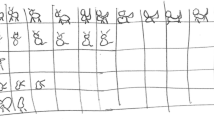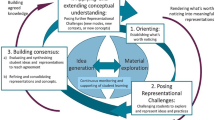Abstract
This chapter examines ninth-grade students’ data-based modelling to estimate previous and unknown Japanese populations. The results of the students’ productions of group and individual models and their individual use of the group models demonstrated that the data-based modelling approach—which involves putting ‘data’ at the core of mathematical modelling—can be used to construct, validate, and revise various models while flexibly combining mathematical, statistical, and contextual approaches generated by using data from real-world contexts. Data-based modelling can be a pedagogically dynamic and flexible approach for balancing the development of generic modelling proficiency and the teaching of mathematics and statistics through real-world contexts.
Access this chapter
Tax calculation will be finalised at checkout
Purchases are for personal use only
Similar content being viewed by others
References
Blum, W., Galbraith P., Henn H.-W., & Niss, M. (Eds.). (2007). Modeling and applications in mathematics education: The 14th ICMI study. New York, NY: Springer.
Brown, J. P. (2017). Context and understanding: The case of liner models. In G. A. Stillman, W. Blum, & G. Kaiser (Eds.), Mathematical modelling and applications: Crossing and researching boundaries in mathematics education (pp. 211–221). Cham: Springer.
Cobb, G. W., & Moore, D. S. (1997). Mathematics, statistics, and teaching. The American Mathematical Monthly, 104, 801–823.
Engel, J., & Kuntze, S. (2011). From data to functions: Connecting modelling competencies and statistical literacy. In G. Kaiser, W. Blum, R. Borromeo Ferri, & G. Stillman (Eds.), Trends in teaching and learning of mathematical modelling (pp. 397–406). Dordrecht: Springer.
English, L., & Watson, J. (2018). Modelling with authentic data in sixth grade. ZDM—Mathematics Education, 50(1–2), 103–115.
Galbraith, P. (2015). Modelling, education, and the epistemic fallacy. In G. A. Stillman, W. Blum, & M. S. Biembengut (Eds.), Mathematical modelling in education research and practice (pp. 339–350). Cham: Springer.
Hestenes, D. (2010). Modeling theory for math and science education. In R. Lesh, P. Galbraith, & C. Haines (Eds.), Modeling students’ mathematical modeling competencies (pp. 13–41). New York, NY: Springer.
Kawakami, T. (2017). Combining models related to data distribution through productive experimentation. In G. A. Stillman, W. Blum, & G. Kaiser (Eds.), Mathematical modelling and applications: Crossing and researching boundaries in mathematics education (pp. 95–105). Cham: Springer.
Kawakami, T. (2018). How models and modelling approaches can promote young children’s statistical reasoning. In M. A. Sorto, A. White, & L. Guyot (Eds.), Proceedings of the Tenth International Conference on Teaching Statistics (ICOTS10). Retrieved from https://iase-web.org/icots/10/proceedings/pdfs/ICOTS10_2G1.pdf
Konold, C., & Pollatsek, A. (2002). Data analysis as the search for signal in noisy processes. Journal for Research in Mathematics Education, 33(4), 259–289.
Langrall, C., Makar, K., Nilsson, P., & Shaughnessy, J. M. (2017). Teaching and learning probability and statistics: An integrated perspective. In J. Cai (Ed.), Compendium for research in mathematics education (pp. 490–525). Reston, VA: NCTM.
Lesh, R., Cramer, K., Doerr, H., Post, T., & Zawojewski, J. (2003). Model development sequences. In R. A. Lesh & H. M. Doerr (Eds.), Beyond constructivism: Models and modeling perspectives on mathematics problem solving, learning, and teaching (pp. 35–58). Mahwah, NJ: Lawrence Erlbaum Associates.
Lesh, R., Middleton, J. A., Caylor, E., & Gupta, S. (2008). A science need: Designing tasks to engage students in modeling complex data. Educational Studies in Mathematics, 68(2), 113–130.
Niss, M. (2008). Perspectives on the balance between applications and modelling and “pure” mathematics in the teaching and learning of mathematics. In M. Menghini, F. Furinghetti, L. Giacardi, & F. Azarello (Eds.), The first century of the International Commission on Mathematical Instruction (1908–2008): Reflecting and shaping the world of mathematics (pp. 69–84). Roma: Instituto della Enciclopedia Italiana.
Smith, S. K., Tayman, J., & Swanson, D. A. (2001). State and local population projections: Methodology and analysis. New York, NY: Kluwer Academic/Plenum Publishers.
Tyuto Gakko Kyokasho Kabushiki Kaisya. (1944). Suugaku (Tyugakkoyou) 4 Dai Ichirui [Mathematics (For Secondary School) 4 Category1]. Tokyo: Okura Insatsujyo. (in Japanese).
Wild, C. J., & Pfannkuch, M. (1999). Statistical thinking in empirical enquiry. International Statistical Review, 67(1), 223–265.
Acknowledgements
We wish to thank Prof. Dr. Akihiko Saeki (Naruto University of Education, Japan) for his helpful comments on earlier versions of this chapter. This work was supported by JSPS KAKENHI Grant Number JP17K14053.
Author information
Authors and Affiliations
Corresponding author
Editor information
Editors and Affiliations
Rights and permissions
Copyright information
© 2021 The Author(s), under exclusive license to Springer Nature Switzerland AG
About this chapter
Cite this chapter
Kawakami, T., Mineno, K. (2021). Data-Based Modelling to Combine Mathematical, Statistical, and Contextual Approaches: Focusing on Ninth-Grade Students. In: Leung, F.K.S., Stillman, G.A., Kaiser, G., Wong, K.L. (eds) Mathematical Modelling Education in East and West. International Perspectives on the Teaching and Learning of Mathematical Modelling. Springer, Cham. https://doi.org/10.1007/978-3-030-66996-6_32
Download citation
DOI: https://doi.org/10.1007/978-3-030-66996-6_32
Publisher Name: Springer, Cham
Print ISBN: 978-3-030-66995-9
Online ISBN: 978-3-030-66996-6
eBook Packages: EducationEducation (R0)




